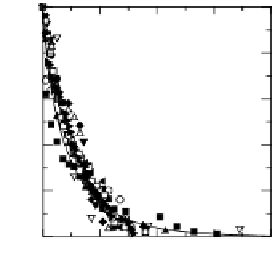Information Technology Reference
In-Depth Information
1.0
1.0
(A)
(B)
0.8
0.8
0.6
0.6
0.4
0.4
0.2
0.2
0.0
0.0
0
1
2
3
4
Food web
Scaled number of prey
Fig. 14.1. Example of \universal" features of food web structure. (A): We plot the cumulative
distribution of the scaled number of prey per species for 11 empirical food webs. The values for each
web are scaled by twice the average number of predator-prey interactions per species in that web.
The solid line is the analytical prediction for many successful static food-web models, including the
niche model [Williams and Martinez (2000)]. The cumulative probability measures the fraction of
events in a sample which has values larger than the set value. That the data \collapse" onto the
same curve is a hallmark of universality. The same phenomenon is observed for the distributions
of numbers of predators and links. (Adapted from Stouer et al. (2005).) (B): We show the
degree of diet contiguity for 14 empirical food webs, as measured by Stouer et al. (2007). All 14
empirical food webs exhibit contiguity very close to 1:0, implying that species and their diets can
very nearly be mapped onto a single dimension. This fact validates an important assumption of
the niche model in which species and diets are explicitly one-dimensional.
same structural properties. An explanation for this universality is the principle
that there are emergent properties in complex systems which arise from constraints
acting upon the system [Amaral and Ottino (2004)]. While bioenergetic constraints
could be considered a major factor controlling food-web structure, it actually ap-
pears that the manner in which species select their prey may be a stronger driver
force [Williams and Martinez (2000); Stouer et al. (2006, 2007); Petchey et al.
(2008); Williams and Martinez (2008)]. These robust patterns have led to the de-
velopment [Williams and Martinez (2000)], and subsequent validations [Stouer
et al. (2005, 2006, 2007); Williams and Martinez (2008)] of a simple static food web
model | the so-called niche model | that reproduces the key structural features
observed in empirical food webs.
To this point, researchers who study food webs have followed a maxim observed
in other disciplines, such as physics: one must understand statics before attempting
to understand dynamics. As noted above, however, ecologists have begun to reach
a consensus regarding the structure and mechanisms which shape the network of
predator-prey interactions [Pascual and Dunne (2006); Stouer et al. (2006); Ca-
macho et al. (2007); Stouer et al. (2007)]; therefore we believe that the time to
advance our understanding of community-wide dynamics is at hand. In the follow-
ing sub-sections, we will outline what we believe to be some of the most exciting
and promising possibilities regarding the topic of food-web dynamics.










